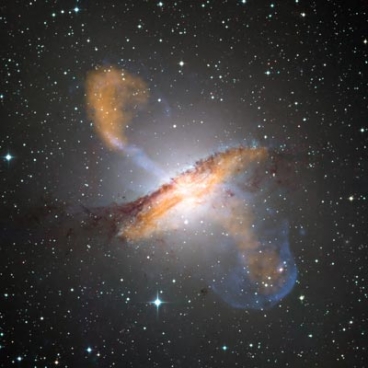About 10 percent of these supermassive black holes feature jets of plasma, or highly ionized gas, that extend perpendicularly from each side of the event horizon — the region from which nothing, not even light, can escape. By spewing huge amounts of mostly kinetic energy from the black holes into the universe faster than the speed of light, the jets control how stars and other bodies form, and play a crucial role in the evolution of clusters of galaxies, the largest structures in the universe.
How the jets form remains one of the most important unsolved mysteries in extragalactic astrophysics, says Dan Evans, a postdoctoral researcher from MIT’s Kavli Institute for Astrophysics and Space Research (MKI), who also says he may be one step closer to unlocking that mystery.
For two years, Evans has been comparing several dozen galaxies whose black holes host powerful jets (the galaxies are known as radio-loud active galactic nuclei, or AGN) to those galaxies with supermassive black holes that do not eject jets. All black holes—those with and without jets—feature accretion disks, the clumps of dust and gas rotating just outside the event horizon.
By examining the light reflected in the accretion disk of an AGN black hole, Evans concludes that jets may form right outside black holes that have a retrograde spin, or that are spinning in the opposite direction from their accretion disk, according to a paper appearing in the Feb. 10 issue of the Astrophysical Journal.
How they did it:
Evans and colleagues from the Harvard-Smithsonian Center for Astrophysics, Yale University, and Keele University and the University of Hertfordshire in the United Kingdom analyzed spectral data collected by the Suzaku observatory, a Japanese satellite launched in 2005 with collaboration from NASA, of a supermassive black hole with a jet located about 800 million light years away in an AGN named 3C 33.
Although we can’t see black holes, scientists can infer their size, location and other properties by using sensitive telescopes to detect the heat they generate, which we see as X-rays. They can also see signatures of X-ray emission from the inner regions of the accretion disk, which is located close to the edge of a black hole, as a result of a super hot atmospheric ring called a corona that lies above the disk and emits light that an observatory like Suzaku can detect. In addition to this direct light, a fraction of light passes down from the corona onto the black hole’s accretion disk and is reflected from the disk’s surface, resulting in a spectral signature pattern called the Compton reflection hump also detected by Suzaku.
But Evans’ team never found a Compton reflection hump in the X-ray emission given off by 3C 33, a finding the researchers believe provides crucial evidence that the accretion disk for a black hole with a jet is truncated, meaning that there is nothing to reflect the light from the corona. They believe the absence may result from retrograde spin, which pushes out the orbit of the innermost portion of accretion material as a result of general relativity, or the gravitational pull between masses. This absence creates a gap between the disk and the center of the black hole that leads to the piling of magnetic fields that provide the force to fuel a jet.

Color composite image of Centaurus A, revealing the lobes and jets emanating from the active galaxy’s central black hole. Composite images: ESO/WFI (Optical); MPIfR/ESO/APEX/A.Weiss et al. (Submillimetre); NASA/CXC/CfA/R.Kraft et al. (X-ray)
Next steps:
According to Evans, this field of research will expand considerably in August 2011 with the planned launch of NASA’s Nuclear Spectroscopic Telescope Array (NuSTAR) satellite, which is 10 to 50 times more sensitive to spectra and the Compton reflection hump than current technology. NuSTAR will help researchers conduct a “giant census” of supermassive black holes that “will absolutely revolutionize the way we look at X-ray spectra of AGN,” Evans said.
Source: “The hard x-ray view of reflection, absorption, and the disk-jet connection in the radio-loud AGN 3C 33,” by D. A. Evans, J. N. Reeves, M. J. Hardcastle, R. P. Kraft, J. C. Lee and S. N. Virani, in the Astrophysical Journal, published Feb. 10, 2010.
Funding: NASA





Comments